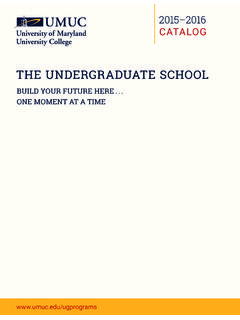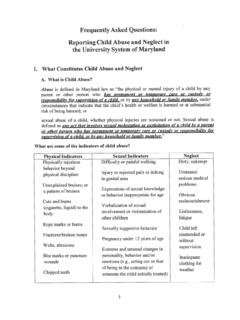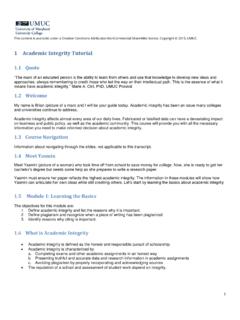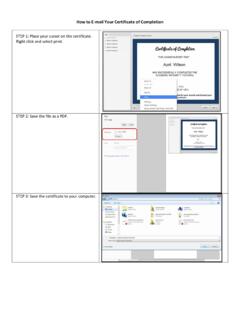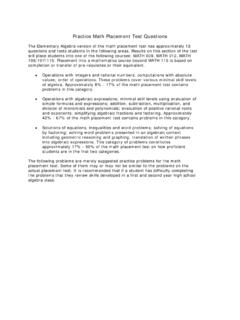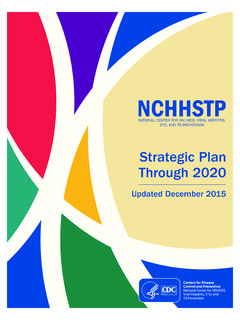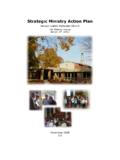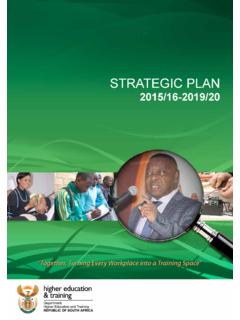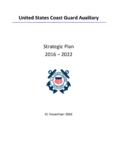Transcription of Strategic Plan 2015-18 - Accredited Online College | …
1 Strategic plan 2015 20182 | UMUC Strategic plan 2015 Dear Colleagues and Friends:I am pleased to share with you the Strategic plan for University of Mary-land University College that will guide our path forward. This docu-ment represents the efforts and insights of our global community. Over the course of my tenure as president, our university has under-gone a significant transformation. We made painful but necessary reductions in personnel and budgets, responding to declines in enrollment. Even as we reduced expenditures, we maintained focus and continued to invest in our Strategic priorities. Our marketing efforts carefully targeted and data-driven have begun to bear fruit, and we have returned to growth the same time, we took steps to remove costly redundancies, moving to one worldwide distance learning operation and centralizing business processes across our three divisions Europe, Asia and stateside. We developed a state-of-the-art analytics program and began the journey to transform our academic model through innovation and technology.
2 We retired our legacy learning management system WebTycho and replaced it with a comprehensive Learning Experience Online (LEO), built around the cutting-edge Desire2 Learn platform. We are well on the way to meeting our goal of adopting open-source educational resources, for both the graduate and undergraduate schools, by the fall of 2016. And we have been granted certain autonomies and flexibilities by the University System of Maryland Board of Regents that better position us to compete in the national and global Strategic plan builds on these transformations and has been shaped by worldwide input and collaboration. It will guide our path forward, clarifying our mission and vision while articulating our goals, cultural aspirations and strategies. It includes critical components that were identified, shared and revised based on input from the university s key stakeholders: faculty, staff, students and of the efforts we have made together, UMUC is today a significantly different, stronger and healthier institution.
3 And with this Strategic plan serving as a roadmap for student success and the university s global growth I am confident that the best is yet to thank you for your continued dedication to and support of our university and our unique ,Javier MiyaresPresidentUniversity of Maryland University College1. LETTER FROM THE PRESIDENTUMUC Strategic plan 2015 | 3 Inside UMUC sAcademicCenter at Largo4 | UMUC Strategic plan 20152 1. Letter from the President8 2. History a. UMUC s Journey b. Our Commitment to Military Education12 3. Leveraging Technology for Adult Education a. Establishing Infrastructure b. Advancing Learning Platforms c. Continuing Technological Evolution14 4. Mission, Vision and Goals a. Mission b. Vision c. Goals Strategic Initiatives 1. Adopting a Single Global Operational Model 2. Improving the Student Administrative Experience 3.
4 Transforming the Core Learning Model 4. Diversifying the Revenue Portfolio 5. Maintaining the University Infrastructure16 5. Changes in the Higher Education Landscape a. Decreases in Government Funding Increases in Student Debt b. The Changing Collegiate Student Population c. Increased Workforce Readiness and Career Focus d. The Skills Gap e. The Call for More College Graduates f. Increased Competition g. Military Education Cuts and Troop Drawdowns Decrease Enrollment h. As Enrollment Becomes Volatile, New Markets Must OpenTABLE OF CONTENTSUMUC Strategic plan 2015 | 518 6. Responses to Changes in the Higher Education Landscape a. Harnessing the Power of Technology to Create Student-Centric Education b. Increased Support and Services for Veterans c. Affordable Tuition for All Students d. Increasing Workforce Readiness and Focus on Student Careers e.
5 Addressing Market Demand for Cybersecurity Professionals f. Groundbreaking Alliance with the Office of Personnel Management g. Unique Experience with Nontraditional Students h. Developing Competency-Based Programs i. Supporting Staff Leadership Training j. Adopting a New Branding Message24 7. Academic Roadmap a. A Redesigned Learner Experience b. Personalized Learner Support c. Workplace-Relevant Curricula and Programs d. Roles of Faculty 27 8. Core Values and Cultural Aspirations a. Core Values b. Cultural Aspirations28 9. Building a UMUC Community a. Transparency and Collegiality b. Commencement c. Alumni and Career Services d. Arts Program e. Outreach f. Accessibility Services30 10. New Business Model31 11. Conclusion32 Appendix A: UMUC Timeline34 Appendix B: UMUC SWOT AnalysisFROM LEFT: UMUC Friends of the Arts at Joseph Sheppard s exhibition opening; Tammy Borkowski,alumna; UMUC EuropeBentley Award Winner;UMUC Padawans incompetiton; recentgraduate at a UMUC commencement.
6 6 | UMUC Strategic plan 2015 UMUC Locations WorldwideUMUC Strategic plan 2015 | 78 | UMUC Strategic plan 2015a. UMUC s JourneyThe history of University of Maryland University College (UMUC) tracks the history of adult and distance education in the United States, and UMUC has consistently been at the forefront of these changes. The university was quick to accept military students, to teach students face-to-face in remote locations, to administer cutting-edge virtual programs and services, and to maintain its strong commitment to educating minority early history of UMUC is inherently connected to the history of the University of Maryland, College Park. That history began in 1807 when the State College of Medicine was founded in Baltimore, Maryland. In 1856, the General Assembly of Maryland established the Maryland Agricultural College in College Park, part of the land grant system of universities, whereby the federal government gave tracts of land to states to establish universities teaching practical subjects, such as the end of World War II, the University of Maryland s student body was typical of a traditional institution, with most students aged 18 22.
7 But returning war veterans began to change the composition of the student body. Most veterans were older. Some lived off-campus and commuted daily. Some were single while others were married with children. Some went to school full-time while others held jobs and attended Using the New GI Bill Transform a UniversityIn 1944, Congress passed the Servicemen s Readjustment Act, which became known as the GI Bill, providing funds for a wide range of educational programs for millions of veterans. This had a lasting impact on institutions of higher education and changed our society by helping to build and expand the American middle class. As the war ended, a record number of veterans began enrolling in colleges and universities across 2. HISTORYUMUC Strategic plan 2015 | 9the United States. Between June and September of 1946, the University of Maryland student enrollment at College Park and Baltimore nearly doubled, from 6,000 to more than 11,000. By the end of the 1947 48 academic year, enrollment had reached 15,000.
8 To accommodate the growing population, the university recognized that it needed to increase the number of courses, classrooms and dormitories for its full-time students on campus and also offer courses both on and off campus for the large number of nontraditional adult students who wanted to take courses on a part-time basis. As a group, these veterans were more mature than the traditional students who entered College immediately after completing high 1947, a new unit was established within the College of Education to administer a number of programs across the state. That affiliate became the College of Special and Continuation Studies CLOCKWISE FROM TOP LEFT: By the time the Asian Division reached its 40th anniversary in 1996, more than 400,000 students had taken courses there; Military students had to do their homework wherever and whenever they could find a place to study; During the early years of the European program, almost all of the students were men serving in the military; University College Chancellor, Stanley J.
9 Drazek (left), registers students for CSCS courses at the | UMUC Strategic plan 20152. HISTORY (CONT.)(CSCS), established to 1) create a home for the College of Military Science and Tactics, established in 1944 to meet the needs of the military; 2) handle the demand for higher education from adult learners; and 3) accommodate traditional students under the Division of General Studies who applied for admission but failed to fulfill the entrance addition, there was a high demand from African Americans who sought admission to the University of Maryland in College Park and Baltimore but, because of segregation, were not allowed to attend. The CSCS accommodated African American students while allowing the state to avoid the issue of integration. Today, UMUC continues to graduate more minorities than any other institution in the Our Commitment to Military EducationIn 1949, the College of Special and Continuation Studies was established as a separate entity from the College of Education.
10 By the fall of 1949, along with a full curriculum offered in the United States, the University of Maryland European Division began offering courses overseas in mathematics, government and politics, military science, economics, German, French, speech, business and public administration, sociology and history. Over the next four decades, the European Division would offer classes in 23 countries in Europe, North Africa and the Middle East; more than 350 education centers throughout the European Command hosted Maryland academic programs; 600,000 service personnel, civilians and family members studied with the University of Maryland European Division; and 28,000 European Division students earned University of Maryland degrees. Additionally, the CSCS continued to expand its programs locally and abroad. The CSCS established the Atlantic Division (Greenland, Iceland, Bermuda and the Azores) in 1951 and, in 1956, gained a foothold in Asia with the establishment of the Far East Division, which included Japan, Okinawa and Korea.
